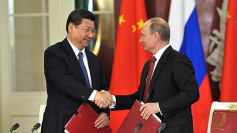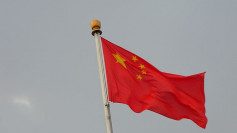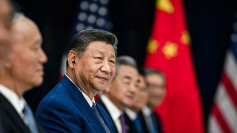China's exports surged 12.4% in March compared to a year earlier, as companies rushed to ship goods ahead of escalating U.S. tariffs, according to customs data released Monday. The sharp increase, driven by front-loaded shipments, outpaced analyst forecasts and comes amid deteriorating trade relations between Washington and Beijing under President Donald Trump's latest tariff escalation.
Exports reached $313.9 billion in March, while imports fell 4.3% to $211.3 billion, producing a monthly trade surplus of $102.6 billion. China's overall trade surplus for the first quarter of 2024 climbed to $273 billion, with first-quarter exports up 5.8% and imports down 7%.
The spike in outbound trade comes as U.S. tariffs on Chinese imports now total 145%, following a series of hikes by the Trump administration. The tariffs, which include penalties tied to China's alleged role in fentanyl production, have triggered retaliatory measures from Beijing. China has imposed 125% tariffs on American goods and restricted exports of critical minerals used in high-tech manufacturing, including electric vehicle components.
"Savvy U.S. importers likely saw tariff hikes coming in April onward and frontloaded imports," ING Economics stated in a note. "It's likely that direct trade between the U.S. and China will crater starting in April."
While exports of low value-added products such as textiles and footwear declined, shipments of semiconductors, electronics, and household appliances increased. Exports of semiconductors rose more than 25% year-over-year, while rare earth exports jumped 20%, even as Beijing tightened export controls on the strategically vital materials.
Shipments to the U.S. rose 9.1% in March, despite the heavy tariffs, while imports from the U.S. fell 9.5%. The U.S. remains China's largest individual trading partner, accounting for roughly 10% of total trade. China's trade surplus with the U.S. reached $27.6 billion in March and $76.6 billion for the first quarter.
Zhiwei Zhang, chief economist at Pinpoint Asset Management, warned that March's growth was temporary. "Exports will likely weaken in coming months as the U.S. tariffs have skyrocketed," Zhang said. "In the short term, I expect chaos in supply chains and potential shortage in the U.S. that may drive up inflation."
In response to supply chain disruptions, the Trump administration exempted certain electronics-including laptops, smartphones, and semiconductors-from the latest tariff round. These items accounted for nearly $174 billion in U.S. imports from China in 2023.
Still, businesses remain wary. "Even if firms decide to relocate their supply chains, it takes time to build factories," Zhang noted. Analysts at Capital Economics said in a report that it "could be years before Chinese exports regain current levels."
China has increasingly turned to other markets. Exports to Southeast Asia rose 11.6% in March, with Vietnam up nearly 19%. Shipments to Africa and India increased more than 11% and 14%, respectively. Exports to the European Union rose 10.3%, while imports from the bloc fell 7.5%.
Chinese customs spokesperson Lyu Daliang acknowledged the "complex and severe external situation," but stressed the resilience of China's export base and domestic market. "At present and in the future, China's import growth space is huge, and the large Chinese market is always a great opportunity for the world," Lyu said.
The spike in exports coincided with Chinese President Xi Jinping's visit to Vietnam on Monday, part of a regional diplomatic push that will also include Malaysia and Cambodia. The trip is widely viewed as an effort to deepen economic ties with other Asian economies facing tariff threats.
Beijing's leaders remain under pressure to boost the domestic economy. Imports of consumer goods, including soybeans, slumped, with soybean imports plunging 36.8% to the lowest level since 2008. Meanwhile, semiconductors and crude oil imports increased 11.2% and 4.8%, respectively.
China is expected to announce its first-quarter GDP figures this week, ahead of a Politburo meeting where officials are expected to unveil new stimulus measures. Goldman Sachs recently cut its China growth forecast for 2024 to 4.0%, citing the disruptive impact of U.S. tariffs.






